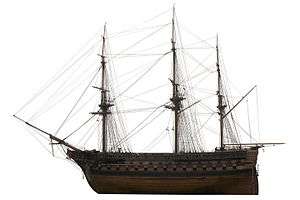French ship Duguesclin (1848)
The Duguesclin was a 90-gun Ship of the line of the French Navy. She was the second ship in French service named in honour of Bertrand du Guesclin.
 1/20th scale model of Suffren, lead ship of Duguesclin's class, on display at the Musée national de la Marine | |
| History | |
|---|---|
| Name: | Duguesclin |
| Namesake: | Bertrand du Guesclin |
| Builder: | Rochefort [1] |
| Laid down: | 26 March 1823 [1] |
| Launched: | 3 May 1848 [1] |
| Stricken: | 17 December 1859 [1] |
| Fate: | Ran aground and lost, scrapped on site |
| General characteristics | |
| Class and type: | Suffren class ship of the line |
| Displacement: | 4 070 tonnes |
| Length: | 60.50 m (198.5 ft) |
| Beam: | 16.28 m (53.4 ft) |
| Draught: | 7.40 m (24.3 ft) |
| Propulsion: | 3114 m² of sails |
| Complement: | 810 to 846 men |
| Armament: |
|
| Armour: | 6.97 cm of timber |
Career
Bayard was first used as barracks for prisoners sent to deportation to Îles du Salut, and then as a transport for those sent to the Bagne of Cayenne. She then took part in the Crimean War in the Black Sea in 1854 and 1855.[1] On 6 July 1854, Duguesclin ran aground on the Warren Rock, off Cronstadt, Russia as the buoy marking it had been removed by the Russians. Her upper and middle deck guns had to be removed before she could be refloated.[2]
In 14 December 1859, as she conducted trials of her newly installed steam engine under Commander Choux,[3] she ran aground on Île Longue. All efforts to raise her proved fruitless and she was scrapped.[1] Her engine was used on Jean Bart.[3]
Notes, citations, and references
Notes
Citations
- Roche, vol.1, p.162
- "The War". Daily News (2551). London. 24 July 1854.
- 90-guns ships-of-the-line Archived 2008-01-20 at the Wayback Machine
References
- Roche, Jean-Michel (2005). Dictionnaire des bâtiments de la flotte de guerre française de Colbert à nos jours 1 1671 - 1870. p. 162. ISBN 978-2-9525917-0-6. OCLC 165892922.
- 90-guns ships-of-the-line